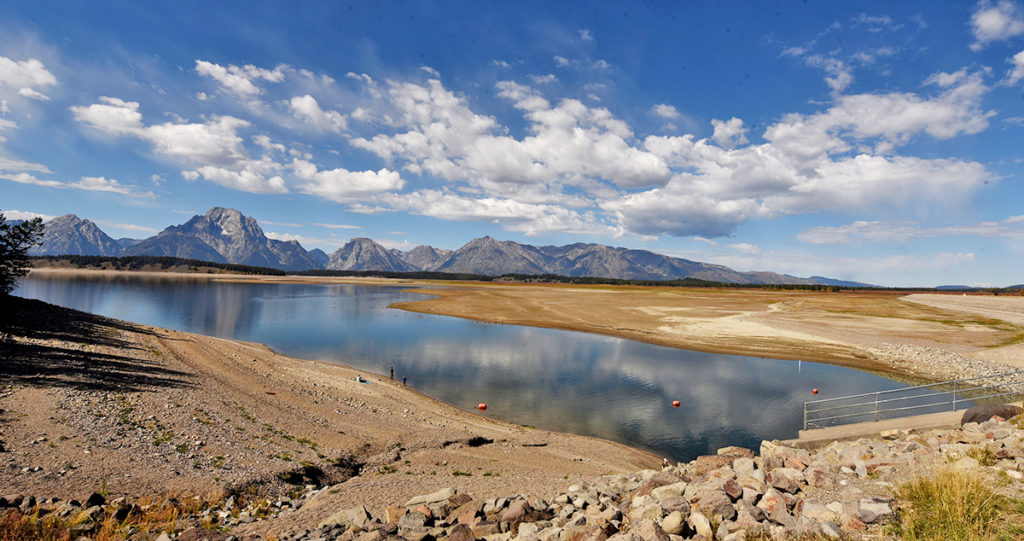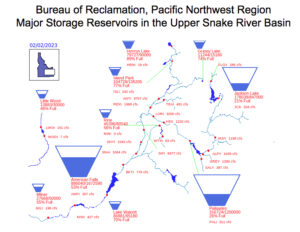
Water Woes in Idaho
All water is not created equal in Idaho. There are senior water rights and junior water rights. What is formally called the law of prior appropriation determines the holder of senior water rights — a right that can be the difference between a bountiful harvest and bankruptcy during a drought.
The law of prior appropriation, often referred to as “first in time, first in right,” was adopted as law by the Idaho Territorial Legislature in 1881 and is part of Article XV in the Idaho Constitution.

There are wet years, there are dry years, and then there are times of drought. And that’s where the contentiousness between senior water rights and junior water rights holders has triggered recent debate. There also is the dichotomy between surface water versus groundwater.
Surface water is comprised of water from the reservoir storage system and diversions from rivers and streams. Groundwater is pumped out of an aquifer estimated to hold water equivalent to Lake Erie — estimated to be 392 million acre-feet.
In an attempt to bridge the troubled waters, the Surface Water Coalition (SWC) and the Idaho Ground Water Appropriators (IGWA) signed an agreement in 2015 to avoid further litigation and a potential water call by the Idaho Department of Water Resources on junior water rights holders to protect senior water rights holders.
The agreement called on the IGWA to reduce groundwater consumption by 240,000 acre-feet annually in an effort to restore the reach gains at Hagerman and American Falls, and restore necessary flow to meet senior water rights. Groundwater users also agreed to not irrigate before April 1 or after Oct. 31.
During 2021 and 2022, the combination of low snowpack, drought and exceptionally hot temperatures early in the growing season and continuing throughout the summer resulted in depletion of storage water and increased demand on groundwater resources. That added up to two years without aquifer recharge in the Eastern Snake Plain Aquifer.
As of Feb. 5, the storage reservoirs of the Upper Snake River Basin were at 40% of capacity.
In August 2022, when it became apparent that IGWA was not going to meet the 2015 agreement, concern arose that the Idaho Department of Water Resources (IDWR) would issue a water curtailment to protect senior water rights.
It’s an argument that has the attention of Idaho’s executive and legislative branches of government.

Idaho Lt. Gov. Scott Bedke, who was Senate majority leader at the time, helped mediate the 2015 Settlement Agreement between the SWC and the IGWA. In his new position as Idaho’s lieutenant governor, Bedke has been given by Gov. Brad Little the task of resolving disputes about the 2015 agreement that have arisen between the SWC and IGWA during the past two years of drought.
“The agreement is adaptive. If it’s not performing like everyone said that it should, then the agreement itself calls for other measures,” Bedke said.
“I think we’ve learned some things since 2015 — that all recharge is not created equal,” he said of the areas of concern.
Bedke also said that it’s important to “maintain and protect the prior appropriation doctrine, and that we don’t support any policies that allow for depletion of the aquifer over time.”
Senior water rights users don’t want to see their junior water rights neighbors put out of business, said Bedke, but the senior water rights users are entitled to their water. Bedke would like to see Idaho capture more of the natural flow and place that water either in storage or in the recharge efforts.
He estimated that between 750,000 and 1 million acre-feet of water, depending on the snowpack, leaves the state during the spring thaw.
“We’ve got to find a bunch of spots above Milner (Dam) that we can put that water into the aquifer and not let any of it leave, and that’s where the state comes in,” Bedke said. “We’re being very aggressive about putting up infrastructure and diverting the water back into the aquifer.”
Jeff Raybould has a unique perspective in the ongoing discussion of Idaho water allocation. Not only is Raybould an Upper Valley potato farmer, he is the chair of the Idaho Water Resource Board.
Raybould recognizes that the current debate over the 2015 agreement for aquifer recharge and the looming potential for water curtailments is one that has been developing for far longer than the past two years.
“I believe we have the ability to manage this thing,” Raybould said. “We’ve been very successful in implementing a managed recharge program.”
Raybould said that there is often a significant amount of annual spring runoff that the state should capture and store.
“On average there is a million acre-feet a year of water that spills over Milner Dam and goes to the ocean because we don’t have enough surface storage, and we didn’t have aquifer recharge capacity to capture those flows,” he said. “I think that we can capture a significant amount of that water as we build up that capacity, and we can manage how we capture and hold that water in the basin. I think maybe we can take care of this additional demand that we see out there to grow more forage crops and still have our other traditional crops have an adequate water supply.”
Cloud seeding is another venue that is helping add to the annual snowpack, Raybould said.
Rep. Stephanie Mickelsen is a first-year legislator in Idaho. Mickelsen’s family is a large agricultural producer in the Upper Valley.
Mickelsen said that the 2015 agreement failed to take into account drought years versus strong water years.
“It’s only been the past two years that there’s been a problem,” she said, “but you also hit hot, dry years. The problem is, when you have something like that, it has to have some flexibility. It becomes a much more challenging situation as far as the reductions go.”
In spite of the drought and the low snowpack the past two years, Mickelsen Farms has met its groundwater reductions every year, she said. However, because the groundwater district that the farm belongs to did not meet its reductions, they were facing a curtailment.
“It’s very punitive to individual growers that met those reductions, that made those adjustments to their operation, that shorted their grain crops in some years,” Mickelsen said. “That’s one of the major problems, if individuals who make the reduction are going to be punished for the group as a whole.”
Mickelsen believes that the canal companies and senior water rights holders need to be more efficient in their water usage. In some ways, it comes down to the definition of beneficial use.
“That’s one of the flaws of the settlement agreement; we have to look at what beneficial use is,” Mickelsen said. “Is it reasonable for the value they’re getting out of shutting off all these acres? Is there a way to make everybody pretty much whole versus some people completely whole, and other people basically get run over by a freight train? I think there’s a balance there, and I think we’re going to have to find that balance.”
One of the architects in the rebuilding of the 2015 agreement is Gary Spackman, director of the IDWR.
At a forum sponsored by the Eastern Idaho Water Right Coalition (EIWRC) in December 2022, Spackman told attendees that the past two years of drought had resulted in a reassessment of both the 2015 agreement and the methodology employed by IDWR in calculating the water supply and potential shortfall for senior surface water rights holders and the resulting obligation for mitigation by junior priority groundwater right holders.
“I believe the holders of senior water rights don’t want to shut off junior groundwater users, and I honestly believe that the holders of junior groundwater rights want to solve the problem,” Spackman told the audience during the annual meeting of the Idaho Water Users Association in January.
Spackman expressed a level of optimism that the SWC and IGWA would reach a settlement, but he urged everyone to assist in helping bring resolution to this dispute.
“Participate in those discussions and try to find a solution that will move us forward so that our water resource, both groundwater and surface water, is sustainable for all,” he said. “I’m a believer that we have the resource available to us, and we just need to manage that resource.”
Top photo: Jackson Lake, nearly depleted, on Sept. 28, 2022. Located in Grand Teton National Park and part of the Upper Snake River storage system. Photo by Bill Schaefer














